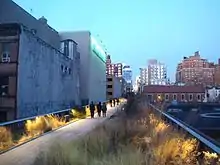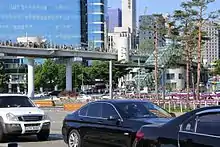Elevated park
An elevated park (sometimes known as a sky park) refers to a park located above the normal ground (street) level. This type of a park has become more popular in the early 21st century, featuring in a number of urban renewal projects.[1][2] While usually associated with repurposed transportation infrastructure, some elevated parks are designed on top of buildings.[3]

Elevated parks can exist, for example, on the roof of existing buildings (see also: green roof, roof garden),[4][3] or on former railways, elevated roads, or other elevated urban elements (often becoming linear parks as well).[5][6][7][8] Examples of a linear elevated park include New York's High Line, Chicago's Bloomingdale Line, or Seoul's Seoullo 7017 Skypark.[5][9][10] One of the earliest of such parks was the Promenade plantée (Coulée verte René-Dumont) in Paris, dating to 1993.[11] It has proven popular enough to encourage other cities to consider similar projects, a process that gained further momentum after the success of the High Line, the first such park in the United States, which opened in 2009.[1][12][13][14][15] Numerous cities worldwide have looked into or started construction of elevated parks, including London, Washington, DC, Jersey City, Chicago, Philadelphia, San Francisco, São Paulo, and Rotterdam.[14][16] In 2015, Hélène Littke noted that the "High Line in New York City started a worldwide trend of elevated parks", and new elevated parks are often compared to it.[17][15]
Elevated parks have been criticized for high costs, though they have generally attracted positive reviews, including from academia.[17][13] Littke observed that "The High Line is undoubtedly loved, and it is a successful place in many ways", and that its success proves that "elevated parks can bring 'new' nature into cities without occupying ground-floor space".[17]
In 2016, a public referendum to convert Seattle's Alaskan Way Viaduct into an elevated park, inspired by the High Line, was strongly rejected by voters.[18]

References
- Carl Grodach; Renia Ehrenfeucht (22 December 2015). Urban Revitalization: Remaking cities in a changing world. Routledge. p. 107. ISBN 978-1-317-91201-9.
- "7 Plans For Elevated 'High Line' Parks Around The World". Business Insider. Retrieved 2017-05-30.
- "Elevated parks in Sacramento – Why Not Here? – Sactown Magazine". www.sactownmag.com. Retrieved 2017-05-30.
- Thomas Schröpfer (1 January 2016). Dense + Green: Innovative Building Types for Sustainable Urban Architecture. Birkhäuser. p. 264. ISBN 978-3-03821-014-6.
- Shirley Jordan; Christoph Lindner (25 February 2016). Cities Interrupted: Visual Culture and Urban Space. Bloomsbury Publishing. pp. 51–52. ISBN 978-1-4742-2444-4.
- C. Greig Crysler; Stephen Cairns; Hilde Heynen (20 January 2012). The SAGE Handbook of Architectural Theory. SAGE Publications. p. 824. ISBN 978-1-4739-7116-5.
- Bruce Sharky (5 February 2016). Thinking about Landscape Architecture: Principles of a Design Profession for the 21st Century. Routledge. pp. 35–. ISBN 978-1-317-53841-7.
- Sinha, Amita (2014-04-03). "Slow landscapes of elevated linear parks: Bloomingdale Trail in Chicago". Studies in the History of Gardens & Designed Landscapes. 34 (2): 113–122. doi:10.1080/14601176.2013.830428. ISSN 1460-1176.
- hermes (2017-05-20). "Say hello to Seoul's new sky park". The Straits Times. Retrieved 2017-05-21.
- Carl T. Hyden; Theodore F. Sheckels (14 January 2016). Public Places: Sites of Political Communication. Rowman & Littlefield. p. 155. ISBN 978-1-4985-0726-4.
- Amalie Wright (19 September 2013). Future Park: Imagining Tomorrow's Urban Parks. Csiro Publishing. p. 38. ISBN 978-0-643-10662-8.
-
- "Leisure in the Sky: 13 Elevated Railway + Rooftop Parks". WebUrbanist. 2013-09-02. Retrieved 2017-05-30.
- Taylor, Kate (2010-07-14). "After Elevated Park's Success, Other Cities Look Up". The New York Times. ISSN 0362-4331. Retrieved 2017-05-30.
- Gastil, Ray (2013-10-01). "Prospect parks: walking the Promenade Planteé and the High Line". Studies in the History of Gardens & Designed Landscapes. 33 (4): 280–289. doi:10.1080/14601176.2013.807650. ISSN 1460-1176.
- "How the High Line Changed NYC | Village Voice". Retrieved 2017-05-30.
- "Photos: The Differing Destinies of Elevated Urban Parks". Retrieved 2017-05-30.
- Rhodes, Margaret. "An Elevated Park That Makes NYC's High Line Look Tiny". WIRED. Retrieved 2017-05-30.
- Littke, Hélène; Locke, Ryan; Haas, Tigran (2016-10-01). "Taking the High Line: elevated parks, transforming neighbourhoods, and the ever-changing relationship between the urban and nature". Journal of Urbanism: International Research on Placemaking and Urban Sustainability. 9 (4): 353–371. doi:10.1080/17549175.2015.1063532. ISSN 1754-9175.
- Madej, Patricia (August 2, 2016). "Voters soundly reject elevated waterfront park for downtown Seattle". The Seattle Times. Retrieved June 1, 2017.